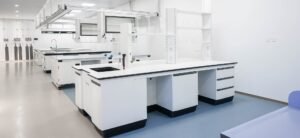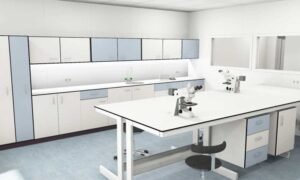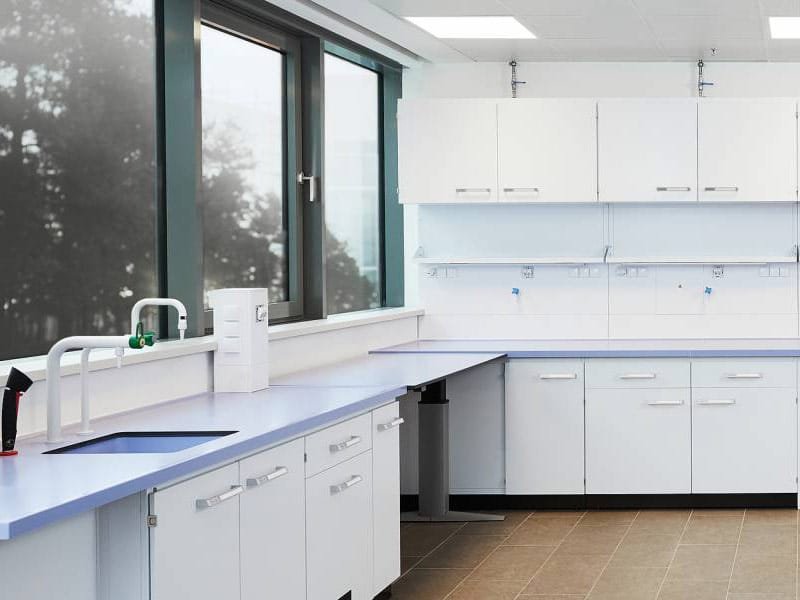Why HPL Laboratory Furniture Is the Best Choice for Schools, Universities, and Research Facilities in Oman
Laboratories in Oman—whether in schools, universities, or research centers—face tough demands. They require furniture that can withstand chemicals, moisture, heavy use, and constant cleaning. Traditional wooden or metal lab furniture often fails in these environments, either corroding, swelling, or becoming unsafe for scientific work.
This is why HPL Laboratory Furniture (High Pressure Laminate Laboratory Furniture) has become the standard for modern labs. At Modon Business, we design and supply premium HPL lab solutions tailored for Oman’s climate and the needs of scientific institutions

What Is HPL Laboratory Furniture?
HPL Laboratory Furniture is built from compact laminate panels manufactured under extreme heat and pressure. This process creates non-porous, chemical-resistant surfaces that are ideal for lab tables, benches, cabinets, and storage units.
These panels are:
-
Dense and durable – resistant to scratches and impacts.
-
Non-reactive – safe for use with acids, solvents, and cleaning chemicals.
-
Hygienic – easy to sanitize and maintain.
Key Benefits of HPL in Laboratory Settings
Chemical Resistance
HPL lab benches resist damage from acids, alkalis, and solvents, ensuring safe long-term use.
Moisture and Heat Resistance
Labs involve water, steam, and heat from equipment. Unlike wood or metal, HPL panels remain stable and unaffected.
Hygiene and Safety
The non-porous surface prevents bacterial growth and allows thorough cleaning—crucial in labs where contamination risks must be minimized.
Durability
HPL furniture resists scratches, dents, and stains, making it perfect for high-usage labs in schools and universities.
Design Flexibility
Available in various finishes and colors, HPL furniture allows institutions to create labs that are both functional and modern-looking.
Applications in Oman’s Educational and Research Sector
-
School laboratories: Safe, durable benches that withstand everyday experiments.
-
University research centers: Customizable HPL furniture designed for long-term projects.
-
Healthcare labs: Hygienic surfaces resistant to contamination.
-
Industrial R&D facilities: Reliable work surfaces for chemical and material testing.
For additional insights into how HPL excels in humid and demanding environments, see our guide on HPL Panels: The Ultimate Guide.
Why HPL Outperforms Traditional Materials
-
Wood: Swells and weakens when exposed to water and chemicals.
-
Metal: Corrodes over time, especially when exposed to solvents or humidity.
-
PVC: Lacks durability and is unsuitable for long-term lab use.
HPL combines chemical resistance, hygiene, and durability, making it the only practical choice for Oman’s labs

Real-World Value
Educational institutions across Oman increasingly choose HPL laboratory furniture because:
-
It reduces replacement and maintenance costs.
-
It supports health and safety compliance.
-
It provides a professional image for students, researchers, and international collaborations.
This is similar to how global organizations trust HPL for long-term durability—explore more in Why Top Brands Like McDonald’s and KFC Choose HPL.
Extending HPL Beyond the Lab
The same advantages of HPL lab furniture apply to:
-
Restroom cubicles – discover why HPL cubicles are the best choice in Oman
-
Lockers – see our article on HPL lockers for schools and gyms
-
Vanities and countertops – learn why HPL excels in kitchens and bathrooms.
This versatility makes HPL one of the most reliable surface materials for education, healthcare, and commercial sectors alike
For schools, universities, and research facilities in Oman, HPL Laboratory Furniture is the superior choice. It resists chemicals, water, and heat; supports hygiene; and offers durability unmatched by wood, metal, or PVC alternatives.
Contact Modon Business today to learn more about our customizable HPL lab furniture solutions and how they can enhance your institution’s safety and performance.


